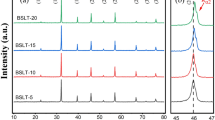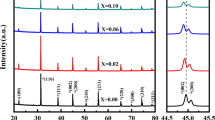Abstract
The dielectric properties of 0.1–15% mol bismuth doped Ba0.6Sr0.4TiO3 (BST) ceramics have been investigated systematically. The solubility limit of bismuth is determined as about 10 mol% by means of both X-ray diffraction and scanning electron microscopy, which is further verified by the fact that the lattice constant of the samples above 10 mol% is almost invariable. The temperature dependence of the dielectric permittivity suggest that the ferroelectric behavior transit to relaxor ferroelectric type when impurity concentration reaches 5 mol%, and further to relaxor behavior for samples above 10 mol% Bi content, which is verified by the absence of a hysteresis loop. Thermal expansion results show differences between 5 and 10 mol% doped samples. Dielectric tunability at room temperature decreases with bismuth content increasing. The variation of properties was attributed to the impurity induced polar regions and former long-order structure.









Similar content being viewed by others
References
Sengupta LC, Sengupta S (1997) IEEE Trans Ultrason Ferrolectr Freq Control 44:792
Gevorgian SS, Kollgerg EL (2001) IEEE Trans Microwave Theory Technol 49:2117
Hwang CS, Park SO, Cho HJ, Kang CS, Kang HK, Lee SI, Lee MY (1995) Appl Phys Lett 67:2819
Liu S, Liu M, Zeng Y, Li C, Chen S, Huang Y, Xia D (2002) Mater Sci Eng C 22:73
Tanaka A (1996) IEEE Trans Electron Devices 43:1844
Cole MW, Hbbard C, Ngo E, Ervin M, Wood M, Geyer RG, (2002) J Appl Phys 92:475
Kang KT, Lim MH, Kim HG, Choi YW, Tuller HL, Kim D, Hong JM (2005) Appl Phys Lett 87:242908
Saha S, Krupanidhi SB (2001) J Appl Phys 90:1250
Wang SY, Cheng BL, Wang C, Dai SY, Lu HB, Zhou YL, Chen ZH, Yang GZ (2004) Appl Phys Lett 84:4116
Jeon YA, Seo TS, Yoon SG (2001) Jpn J Appl Phys Part 1 40:6496
Radhapiyari L, James AR, Thakur OP, Prakash C (2005) Mater Sci Eng B 117:5
Sun X, Zhu B, Liu T, Li M, Zhao X, Wang D, Sun C, Chan HLW (2006) J Appl Phys 99:084103
Cole MW, Joshi PC, Ervin MH (2001) J Appl Phys 89:6336
Kim KT, Kim CI (2003) Microelectron Eng 66:835
Zhou L, Vilarinho PM, Baptista JL (2001) J Eur Ceram Soc 21:531
Chen W, Yao X, Wei X (2007) Solid State Commun 141:84
Yun S, Wang X (2006) Mater Lett 60:2211
Samara GA (2003) J Phys Condens Matter 15:367
Burns G, Dacol FH (1983) Phys Rev B 28:2527
Burns G, Dacol FH (1983) Solid State Commun 48:853
Burns G, Dacol FH (1984) Phys Rev B 30:4012
Chong KB, Kong LB, Chen L (2004) J Appl Phys 95:1416
Laguta VV, Glinchuk MD, Bykovi P, Rosa U, Jsastrabik L, Savinov M, Trybula Z (2000) Phys Rev B 61:3897
Nowick AS, Fu SQ, Lee WK, Lin BS, Scherban T (1994) Mater Sci Eng B 23:19
Kleemann W, Albertini A, Kuss M, Lindner R (1997) Ferroelectrics 203:57
Acknowledgements
This work was supported by the Ministry of Science and Technology of China through the 973 project under Grant No. 2002CB613304 and NSFC under Grant No. 50402015.
Author information
Authors and Affiliations
Corresponding author
Rights and permissions
About this article
Cite this article
Chen, W., Yao, X. & Wei, X. Structural and dielectric properties of Bi doped Ba0.6Sr0.4TiO3 ceramics. J Mater Sci 43, 1144–1150 (2008). https://doi.org/10.1007/s10853-007-1965-3
Received:
Accepted:
Published:
Issue Date:
DOI: https://doi.org/10.1007/s10853-007-1965-3




